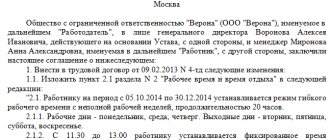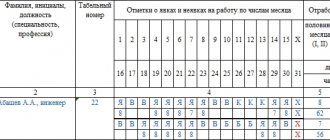An important point: if an employee voluntarily works longer than expected, such overtime work is not recognized and is not paid additionally. The employer must involve the employee in working beyond the norm, having received written consent. And in this case, management is obliged to calculate overtime work. In addition, if an employee’s employment contract establishes an irregular working day, working beyond the allotted time is also not considered overtime. Workers with irregular schedules are entitled to another benefit - additional leave.
How are overtime hours calculated?
HR and accounting department employees are required to correctly take into account the duration of work for each employee.
According to Art. 91 of the Labor Code of the Russian Federation, the normal length of working time is 40 hours per week. It is important to remember that an employee should not work beyond the norm for more than 4 hours, 2 days in a row and longer than 120 hours a year (Part 6 of Article 99 of the Labor Code of the Russian Federation). For some categories of citizens, a shortened day (24-35 or 36 hours a week) is the norm, and working beyond this time is overtime for them. The time worked must be reflected in the working time sheet, form T-12 or T-13. Overtime hours o or code 04. There is a timesheet program for calculating overtime hours, which automates filling out the timesheet and calculates payment for overtime using formulas.
Overtime work is paid at an increased rate (Article 152 of the Labor Code of the Russian Federation):
- for the first 2 hours at one and a half times;
- for the following hours - double.
Instead of increased pay, the employee can choose another option - get additional time for rest (no less than he worked overtime). In this case, processing is still paid, but at a single rate.
What is the minimum amount an employer must pay for working after hours?
Article 152 of the Labor Code of the Russian Federation does not contain an answer to this question, and officials of the Ministry of Health in a letter dated 07/02/14 N 16-4/2059436 explain the situation as follows: to pay overtime you can use the rule of Art. 153 Labor Code of the Russian Federation. According to the norm of this article, the minimum amount of double payment is a double tariff without taking into account compensation and incentive payments. According to the logic of this norm, the least that an employer must pay is the employee’s average hourly earnings without bonuses and allowances, multiplied by 1.5 or 2 and multiplied by the number of hours worked in excess of the norm. Local regulations of a particular company, labor and collective agreement may establish higher payment for overtime: allowances and additional payments are included in the calculation in whole or in part, if the employer is ready for this.
Formula for calculating overtime:
What does the Labor Code say about keeping summarized records of working time?
The employer must keep records of the time actually worked by each employee. Let us recall that working time is the time during which an employee must perform labor duties in accordance with the internal labor regulations and the terms of the employment contract (Article 91 of the Labor Code of the Russian Federation). In this case, the normal working time is 40 hours per week - five working days of eight hours.
When, due to the conditions of production (work) in the organization as a whole or when performing certain types of work, the daily or weekly working hours established for a given category of workers cannot be observed, it is permissible to introduce its summarized accounting. The relevant provisions are contained in Art. 104 Labor Code of the Russian Federation.
Note!
The procedure for introducing summarized recording of working time is established by the internal labor regulations of the organization (paragraph 3 of article 104 of the Labor Code of the Russian Federation).
The rules must establish the duration of the accounting period - it can be a month, a quarter, a half-year, a year. Let us remind you that the procedure for calculating the norm of working time for certain calendar periods of time (month, quarter, year) depending on the established duration of working time per week was approved by Order of the Ministry of Health and Social Development of the Russian Federation dated August 13, 2009 N 588n. This order stipulates that the standard working time for a specific month is calculated using the following algorithm: first, the length of the working week (40, 39, 36, 32, 30, 24, etc. hours) is divided by 5, then multiplied by the number of working days according to the calendar five-day work week for a particular month.
For example, an employee’s working week is set at 36 hours. Consequently, in April 2011, the standard working time will be 151.2 hours (36 hours / 5 days x 21 days).
From the resulting number of hours, the number of hours in a given month is subtracted by which working hours are reduced on the eve of non-working holidays. For example, according to an employee’s employment contract, the working week is set at 40 hours. Therefore, in March 2011, the standard working time will be 175 hours ((40 hours / 5 days x 22 days) - 1 hour).
The annual working time standard is calculated in a similar manner, with the number of working days and pre-holiday hours taken not for a specific month, but for the entire year.
Example 1
The organization has introduced summarized recording of working hours. The accounting period for employees is set as a quarter. The actual number of working days (hours) in the first quarter of 2011 with a five-day working week with two days off (Saturday and Sunday) is:
— in January — 15 working days. days (120 h);
— in February — 19 working hours. days (151 h);
— in March — 22 working hours. days (175 hours).
With a 40-hour work week, the standard working time in the first accounting period is 446 hours.
In accordance with the approved work schedules for the first quarter of 2011, the employee worked:
— in January — 148 hours;
— in February — 144 hours;
— in March — 154 hours.
Thus, the actual number of hours worked by the employee is within the normal range for the first quarter (446 hours).
Calculation of overtime hours based on salary
To calculate additional payments, you need to calculate the hourly part of the salary - how much the employee earns per hour. Then pay one and a half or two times more for each hour of overtime (depending on the time worked above the norm). The formula for calculating the amount earned per hour is given in the letter of the Ministry of Health dated 07/02/14 N 16-4/2059436:
To calculate this formula, the average monthly number of working hours per year is taken - the average value for the whole year is displayed, and not the actual number of hours worked in a month.
But this is not the only method for calculating hourly earnings. There is also an option taking into account the actual working hours in a particular month. To do this, there is no need to divide the hours by 12 months; it is enough to divide the salary by the hourly work rate for a separate month:
Since there are different options, the method for calculating the hourly tariff rate must be fixed in the local acts of the company or in an agreement with the employee (collective or labor).
The norm of working time in a year or month is determined according to the production calendar (see production calendar) depending on which category the employee belongs to (whether he is entitled to a shortened working week).
Types of working time recording
Working time can be counted in different ways, depending on the specifics of the job. The main goal of different methods of recording working time is to ensure the normal length of the working week (month, year). Normal working hours cannot exceed 40 hours per week (Article 91 of the Labor Code of the Russian Federation). To do this, working time is taken into account: daily, weekly or cumulatively.
In case of daily accounting , it is assumed that the duration of the daily shift is the same. The most common option: 8 hours of work per day for a 40-hour work week. Then work in excess of this norm is recognized as overtime in any case, even if the employee thus tries to compensate for the shortfall of the previous day.
When accounting on a weekly basis, it is important to maintain the working hours during the week. The usual option is a 40-hour work week; for some categories of employees a shorter work week is established. On different days of the week, an employee can work a different number of hours, but in total the weekly norm must be observed. Weekly accounting is suitable for flexible schedules or shift work.
Summarized accounting is introduced when necessary for production purposes:
- if the work is organized on a rotation basis;
- with a flexible schedule;
- in multi-shift mode;
- when working around the clock.
Summary accounting can be entered for the entire organization or for some employees, as well as for certain types of work. The rules for introducing summarized accounting are prescribed in Art. 104 Labor Code of the Russian Federation.
An example of calculating overtime hours with a salary
Salary of employee Malofeeva L.G. is 25,000 rubles per month. In September 2021, the employer delayed him twice: on September 1 for 3 hours, on September 8 for 1 hour. We will calculate overtime if the norm is for Malofeev L.G. 40-hour, five-day work week.
The first method (based on the average monthly number of working hours in 2016):
In 2021, the average annual working time for a 40-hour week is 1974 hours (see production calendar). Let’s calculate the hourly part of Malofeev’s salary in average form:
For overtime work on September 1, Malofeev L.G. will receive:
For September 8:
In total, the employee was credited 759.85 + 227.95 = 987.80 rubles in September 2021. for working overtime.
Second method (based on the actual number of working hours per month):
In September 2021, the average monthly working time for a 40-hour week is 176 hours (see production calendar). Let us calculate the hourly part of L.G. Malofeev’s salary. based on the actual (not average) number of working days in September:
We see that the result is a completely different amount of hourly earnings than when calculating using the first method (almost 10 rubles less). But at the same time, in another calendar month - in which the number of labor hours is less than in September - the amount obtained, on the contrary, will be greater than with the average annual calculation.
For September 1, Malofeev will receive:
For September 8:
Total for September 2021 Malofeeva L.G. overtime accrued: 710.20 + 213.06 = 923.26 rubles.
The amount turned out to be less than in the first case, which is unprofitable for the employee. The Ministry of Labor in letter No. 1202-21 dated 08/09/2002 recommends using the first method of calculating overtime if this improves the employee’s financial situation.
Features of summarized working time recording
If an enterprise introduces summarized recording of working hours, then a special work schedule is introduced for this purpose. First of all, the period within which working time will be taken into account is established. Most often, this accounting period is associated with the production cycle of the enterprise and can be anything: a week, a month or a quarter, but not more than a year. And for employees of enterprises with dangerous or harmful working conditions, the accounting period should not exceed three months. You also need to establish the standard working hours for the accounting period. It should not exceed the normal number of working hours. You should focus on the norm of 40 working hours per week (or less, for some categories of employees), according to Art. 91 and 94 of the Labor Code of the Russian Federation.
When calculating working hours, only those days that the employee actually worked are taken into account. Periods of any vacations, sick leave, days of medical examination or donor days, etc. are excluded.
An example of calculating working hours with summarized accounting
The organization has adopted summarized recording of working hours. The accounting period is quarter. Some employees work in shifts, and some work in a regular 5-day week of 40 hours with two days off. For them, the number of working days by month is distributed as follows: in April 2021 - 22 days, in May - 18 days, in June - 19. A total of 59 working days, of which three pre-holiday days are shortened by one hour - this is April 30, May 8 and June 11. In the second quarter, the standard working time will be: 59 × 8 – 3 hours = 469 hours with a 40-hour work week.
Calculation of overtime hours on a shift schedule
According to Art. 103 of the Labor Code of the Russian Federation, a shift schedule implies work in two, three or four shifts, the need for which is determined by the continuity of the production process. Shift work must be fixed in the employment contract with the employee, since it is its essential condition. If a shift worker, at the request of the employer, goes out of his shift, then the payment for that day is doubled, or the employee is given a day off on his working day. If the scheduled shift falls on a holiday, non-working day, the work is paid twice as per Art. 153 Labor Code of the Russian Federation. In addition, the shift or part of it may fall at night, work during which is paid at an increased rate (at least 20%) according to Art. 96 Labor Code of the Russian Federation.
When an employer delays a shift worker at work beyond the scheduled hours, he is obliged to pay the employee additionally. Let's figure out how to calculate overtime hours on a shift schedule. And also if work beyond the norm occurs at night. The formula for calculating the amount of overtime does not change: the first two hours are paid at one and a half times the hourly portion of earnings, subsequent hours at double. As an example, let’s take the calculation of overtime and night shifts in a medical institution.
The specific nature of the work of doctors requires the presence of staff in the institution around the clock; the work schedule in the hospital is rotating. Moreover, in case of delay of doctors and other medical workers beyond the shift, management is obliged to pay for overtime. Let's figure out how to calculate night and overtime pay for doctors.
An example of calculating overtime and night pay on a shift schedule
Medical worker I.P. Trifonov has a work schedule of two 12-hour shifts (day shift from 8:00 to 20:00, night shift from 20:00 to 8:00). The employee's salary is 16,000 rubles. The norm for Trifonov I.P. is a 40-hour work week. In September 2016, he was required to work overtime for 4 hours on September 2 after the day shift, and for 2 hours on September 5 after the night shift. The local regulatory act of a medical institution establishes an additional payment for night work in the amount of 40% of the official salary (the minimum amount of such additional payment according to the Labor Code of the Russian Federation is 20%, but employers have the right to establish more favorable conditions for employees). We will calculate the additional payment for I.P. Trifonov for work outside of school hours.
According to the production calendar in September 2021, for a 40-hour work week, the standard working time is 176 hours. To calculate overtime, we will highlight the hourly part of I.P. Trifonov’s salary:
Night hours are the time from 22:00 to 6:00 (work at this time is paid at an increased rate). September 2 Trifonov I.P. was brought to work after the day shift for 4 hours, the shift ends at 20:00. The employee worked overtime from 20:00 to 24:00, 2 hours of this period were at night. For these 2 hours, he is entitled to an additional 40% of the salary, in addition, they are paid at double the rate, while the first 2 hours of overtime are paid at one and a half times. But when calculating overtime and night, there is no need to multiply the coefficients at the same time. You should add up the amount of extra pay for night hours and the amount of overtime.
For September 2, Trifonov is entitled to:
Of which 72.72 rubles are for work on the night shift.
After the night shift on September 5, Trifonov worked 2 hours - the work occurred during the day, did not exceed 2 hours and was paid at time and a half.
Overtime for September 5:
Total in September Trifonov I.P. accrued for additional work, partly at night, 709.02 + 272.70 = 981.72 rubles.
Calculation of overtime with summarized recording of working time
According to Art. 104 of the Labor Code of the Russian Federation, in cases where it is impossible to comply with the daily (8 hours in the general case) or weekly (40 hours) standard working time, it is permissible to introduce a summarized recording of working time in the organization. Working hours are counted not for a week, but for the period established by the organization. This could be a month, a quarter or a year. Such accounting is introduced so that the duration of working hours does not exceed the normal number of working hours in the entire allotted period. In this case, one week an employee may work more than normal, and the next week, on the contrary, less. The employer will evaluate the time worked after the end of the accounting period - month, year or quarter.
Summarized accounting is convenient for companies with a shift schedule, in which employees work every other day, two to two, or several shifts a day. With such accounting, overtime may also arise, for which it is necessary to calculate payment.
Additional payment for extracurricular work in the case of cumulative recording of working hours is made after the end of the accounting period. Let's look at how overtime is calculated using an example.
Overtime with cumulative accounting
Article 99 of the Labor Code of the Russian Federation states that when recording working hours in aggregate, overtime work is work in excess of the normal number of working hours during the accounting period.
The accounting period can be a month, a quarter, or a year. But the Labor Code of the Russian Federation does not stipulate that, with cumulative accounting, overtime work can exceed 4 hours for two days in a row and 120 hours per year. Moreover, according to Article 99 of the Labor Code of the Russian Federation, the employer is obliged to ensure accurate recording of the duration of overtime work for each employee, including cumulative accounting. The question arises: how to combine summarized accounting with accurate accounting of the duration of overtime work? There is really no contradiction. Overtime hours payable are calculated using the timesheet on a monthly basis. With summarized accounting, payment is made at the end of the accounting period, after analyzing the time worked.
Please note - payment is made, but not accounted for. At the end of the accounting period, the actual time worked is calculated and it is determined which of the hours worked should be paid as overtime.
Initially, work schedules for summarized accounting are formed without taking into account overtime. By planning overtime hours in advance, the administration violates the procedure for involving an employee in overtime work. The employee, in accordance with the provisions of Article 99 of the Labor Code of the Russian Federation, must obtain written consent to work overtime.
At the end of the accounting period, you must enter Overtime Payment documents indicating specific days and hours. In this case, the following must be taken into account:
- the day must be a working day, it cannot all be overtime, because then it will be work on a day off;
- When calculating overtime hours, it is necessary to exclude from the working time norm the time when the employee did not work for a good reason (illness, vacation). The standard working time in such cases is reduced, and overtime hours are determined beyond this new standard;
- overtime work cannot exceed 4 hours for two consecutive days;
- overtime work cannot exceed 120 hours per year.
If necessary, if this time was paid according to the tariff, you need to re-calculate wages, because in the Labor Code of the Russian Federation there is no concept of additional payment for overtime work - there is payment at one and a half and double times. To do this, in the program “1C: Salary and HR Management 8” you need to adjust the work schedules of employees and in the document of the previous period, Payroll for employees of the organization, by clicking the Correct button, create a recalculation document.
An example of calculating overtime with summarized recording of working hours
To employee Selivanov M.A. The hourly wage is set at 150 rubles per hour, the organization operates a summarized recording of working time, the accounting period is a quarter. The general working hours for this employee are 40 hours per week. Let's calculate overtime for Selivanov M.A for the 2nd quarter of 2021, if he worked 496 hours in this quarter according to the time sheet.
According to the production calendar, the standard working time for a 40-hour week in the 2nd quarter of 2021 is 488 hours.
According to the results of the quarter, Selivanov worked 496 - 488 = 8 hours of overtime. Of this time, 2 hours are paid at one and a half times, and the remaining 6 hours at double:
Payment for overtime work Selivanova M.A. will amount to 2,250 rubles based on the results of the accounting period - 2 quarters of 2021 with summarized accounting of working hours.
How to calculate overtime hours when recording working hours summed up
Summarized recording of working hours is used if, due to the specifics of production in the company, it is not possible to maintain the standard duration of the working week.
Hours of work are calculated not for a week, but for a period established by the administration of the enterprise: a month, a quarter or a year. Similar accounting is introduced for control: the total duration of working hours in a specified period, for example a quarter, should not exceed the legal norm. Those. You can work overtime one week, and underwork the second, etc. The results are summarized at the end of the accounting period. Then the hours of overtime work are calculated in the aggregate accounting of working hours. A distinctive feature of this type of labor accounting is that overtime in hours is summed up for the entire period, and the first 2 hours are paid at one and a half times and the rest at double.









